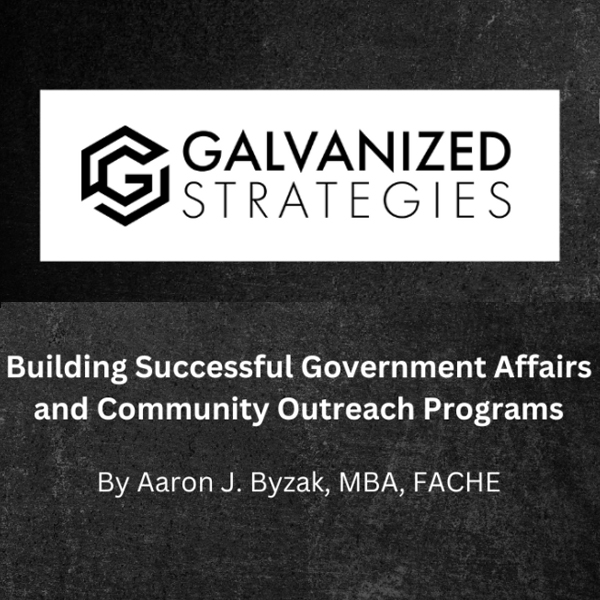Over the years I’ve been approached by many individuals who are interested in how best to develop effective government affairs and advocacy programs and initiatives. Some want to advance legislation, others to build relationships with local, state, and federal elected officials and opinion leaders, while still others want to kick start a discussion that will eventually lead to positive policy change. Some represent organizations that are frequently targeted, negatively more-often-than-not, by legislators.

Building Successful Government Affairs and Community Outreach Programs
As someone who has operated in this space for some number of years, and who has both government affairs, policy, and advocacy successes and failures to look back on, you can imagine that I have opinions on the subject. My goal today is to share some of that insight to help you advance your efforts.
Here is what I’ve learned over the years: Successful government affairs program should NOT strike an even balance between proactive and reactive efforts. Rather, they need to be much MORE proactive than reactive.
Sometimes it is instructive to compare one industry to another to help illustrate the point. As someone who has a background in Emergency Medical Services (EMS), and who worked closely with fire departments for years, I look at it similarly to wildfires.
Much like policy or political challenges (and opportunities), major wildfires may only happen every number of years. When they do, they destroy large amounts of land and property, and, unfortunately, result in loss of life. They have the potential to completely upend communities. That is why our efforts to proactively clear bush, thin diseased forests, and create defensible space around important structures are important. Such efforts will inevitably lead to smaller or more manageable wildfires. Fires will always happen — nature and human beings will always start fires. But would you prefer that the fires be small, and the damage relatively less severe, or would you prefer to fight massive conflagration fires every few years? The choice is clear. Think 90% brush clearance, 10% firefighting.
Government affairs is similar. If you don’t clear the brush, you’ll spend your time fighting massive fires.
That means that you should spend most of your time building relationships, providing insight and information to current and emerging leaders, and building positive collaborations. Much like brush clearance is for firefighters, this is the less sexy part of the advocacy game for government affairs practitioners, but it is essential.
Reactive government affairs — usually occurring when you must respond to something negative like legislation targeting your industry (or organization) or occasionally try to capitalize on a potentially positive opportunity, say new legislation that could benefit your industry or a new government grant that could help one of your initiatives — should not be the only times that you are interacting with elected officials. Relationships should be built over months, years, and decades. You need to get to know elected officials before they are elected officials. Build authentic connections and help them understand who you are, what you stand for, and why your organization is important for the community. You should be giving, giving, and giving some more, and only asking for support or help occasionally, and almost begrudgingly.
“Look, I hate to even bring it up, but I’d be doing my organization and our community a disservice if I didn’t mention that (insert legislative title or number) will positively (or negatively) impact what we’re trying to do. Here’s why…”
What Does a Government Affairs Plan Include?
First and foremost, you need an underlying philosophy that is rooted in a value system. For me, that philosophy reads as follows:
“The foundation of great government affairs is amazing community engagement. Amazing community engagement comes from understanding and aligning what the community wants and needs, what your organization does well, and what you and your team are passionate about.”
In short, your number one priority should be amazing community outreach and engagement. Positive government affairs is a related endeavor that becomes much easier if you remain focused on priority one.
Let’s explore this further.
You must have a deep awareness and appreciation for what your community wants and needs. This can be achieved by diving into the quantitative and qualitative data available about your community, coupled with your understanding of different socioeconomic, cultural, and other realities in the region, as well as an appreciation for the individuals who are influential in that community. You also need to have a strong understanding of your organization’s own mission and capabilities. Not just the mission that appears in the strategic planning binder — the real mission that your organization seeks to achieve every day and the areas in which your organization has unique or excellent capabilities that have been proven over time. In short, what are you good at and what do you like doing, from an organizational perspective. And finally, what are the passions of the staff responsible for conducting your government affairs and community outreach? What would make them get up in the morning every day and pursue positive outcomes?
Identify those key understandings (we’ll refer to them as data and anec-data points) and create a Venn diagram that outlines that information. In doing so, you will start to notice areas of overlap where there is clear alignment between the three primary drivers (community, organization, and individuals/team).
Everything that falls in the middle of the Venn diagram is your target.
Make & Execute a Plan
Now you create an achievable plan with clear goals and tactics, identify and allocate appropriate resources based on a realistic budget, assign the correct people, and ensure that they have a commitment to seeing the project through to its end, and then execute with a ferocity that few can comprehend. That’s not to say that you should be mean. Far from it. It means that you should tackle this endeavor with intensity and sincerity.
When people see you being your authentic self in the pursuit of needed improvements in the community, and leveraging the unique capabilities of your organization, it clears a lot of brush, to revisit our wildfire analogy. Pursue it with vigor, because it’s the right thing to do and your fellow community members will benefit from it and share your successes (and challenges) with those in positions of influence (elected officials, business leaders, etc.). Bring them along on your journey.
Simultaneously, get to know those elected officials and emerging leaders. Understand their interests and goals – professional, personal, and political. Find alignments. Create opportunities for collaboration. Help inform and educate and grow them into the leader they want to be — and need to be. Bring them ideas, connect them with like-minded friends and colleagues. All the while, you should be tracking legislation that is important to your industry, organization, and initiatives, and study changes in the political and policy landscape. Develop a public policy agenda with well thought-out goals that clearly define what you want to support, and oppose, and why.
Recognize patterns of behavior. Learn who the power brokers and decision makers are. Who is disproportionately influential, and why are they so? Find out who likes who, and who doesn’t like who. Using all this information, try to predict the future, to the extent possible. How? If you want to know what people will do in the future, look at what they did in the past. Learn what has happened historically — by doing so, you will be able to manifest a sort-of crystal ball that will help you predict the future, or at least anticipate changes, to one degree or another.
Then, when the time comes and you need to take government affairs, advocacy, or policy action to advance your organizational, industry or initiative goals, you’ll be well positioned as a community-focused individual, representing a committed and known organization, who is a giver and who is only, somewhat begrudgingly, asking for support for a legislative/policy effort that isn’t self-serving, but community serving, and will be seen not as a “give me” by the legislative leader but rather as a natural progression of a long-standing collaborative effort.
That, my friends, is good government affairs.




